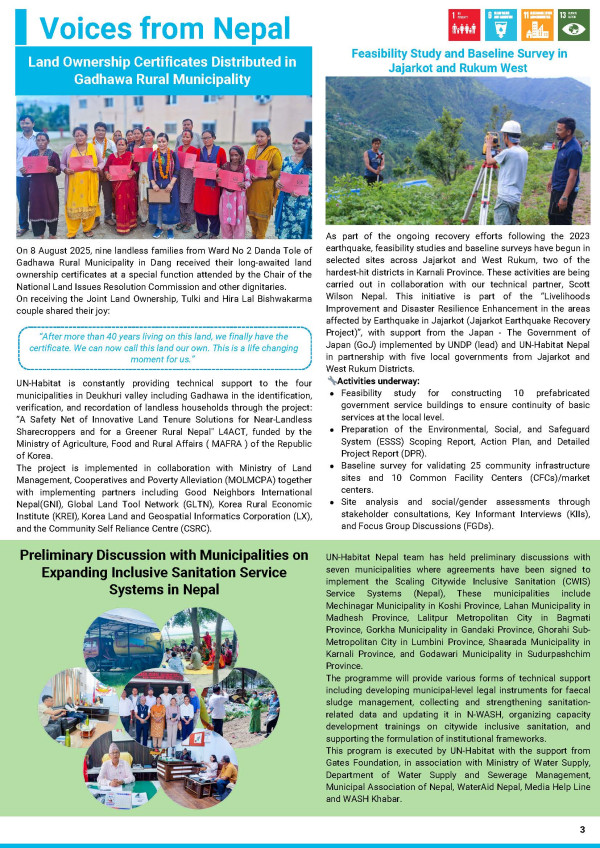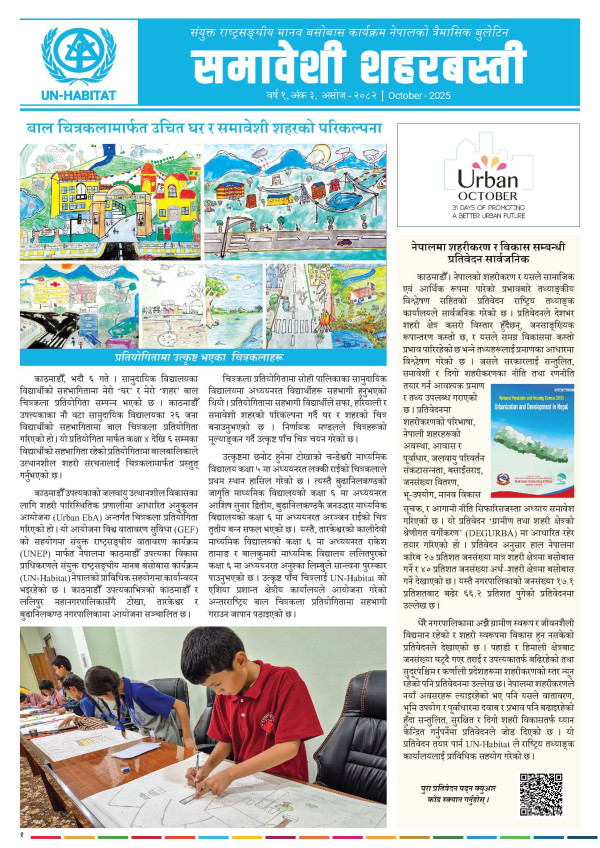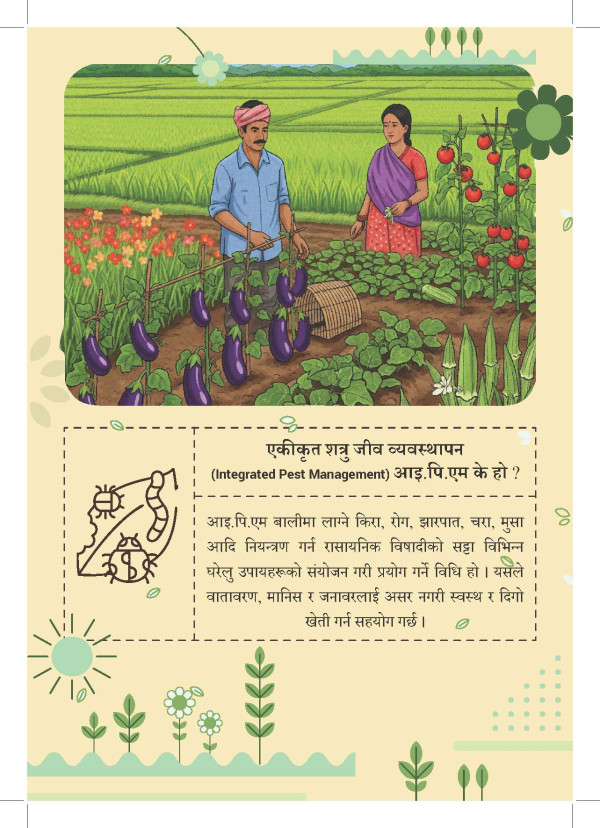Urban Stakeholders in Nepal kickstarts Urban October by organizing World Habitat Day 2024 and Nepal National Urban Forum

7 October 2024, Kathmandu
Ministry of Urban Development (MOUD), Government of Nepal in collaboration with UN-Habitat Nepal, Department of Urban Development and Building Construction (DUDBC), Nepal National Urban Forum (NNUF) and various national urban stakeholders, organized a one-day event to commemorate the World Habitat Day (WHD) 2024 with the theme “Engaging Youth to Create a Better Urban Future” and convene the Nepal National Urban Forum with the theme “Financing Localization and Localizing Finance” on 7th October, 2024 in Kathmandu, Nepal. The event brought together national and local leaders, policymakers, urban planners, youth advocates, academia, non-government organizations and key stakeholders in an engaging discussion on youth inclusion in urban development to lead sustainable urbanization in Nepal. The event was graced by Honourable Deputy Prime Minister and Minister MOUD Mr. Prakash man Singh, and special guests including Dr. Ramesh Prasad Singh, Honourable Member of the National Planning Commission (NPC); D.. Sohan Prasad Sah, Honourable Vice Chairman of the Province Policy and Planning Commission, Madhesh Province; Mr. Maniram Gelal, Secretary, MOUD; Ms. Hanaa Singer Hamdy, United Nations Resident Coordinator in Nepal; Mr. Ghanashyam Giri, Mayor of Chandragiri Municipality; Mr. Machakaji Maharjan, Director General (DG) of DUDBC; and Prof. Dr. Sangeeta Singh, Convenor of the NNUF and Mr. Dilip Bhandari, Joint Secretary, MOUD and Chair of the session.
The formal inauguration was held by launching the Voluntary Local Report (VLR) of Chandragiri Municipality. The VLR report of Chandragiri is a significant step in localizing the Sustainable Development Goals (SDGs) 2030 that provides valuable insights into the municipality’s progress towards the SDGs, highlighting institutional, resource, and implementation gaps that guides the actions for the municipality to achieve the targets and the importance of local action to achieve the national targets and commitment.
In the welcome remarks, Mr. Rabindra Bohara, Deputy DG, Housing Division, DUDBC highlighted Nepal’s long-standing commitment for sustainable urban development, focusing on creating safe, resilient, and inclusive cities. He emphasized the need for young people, who are often excluded from key decision-making processes, to be engaged as key stakeholders in leading national development.
The keynote speech from Dr. Sohan Prasad Sah provided the contextual scenario of Madhesh Province, highlighting youth-driven efforts that have brought visible impacts in preserving environment and transforming lives of the marginalized communities. He underscored the need of building upon and harnessing the agencies of the youth to make meaningful impact. He highlighted with data, the challenges of migration in the province, noting that youth have often been excluded from education, health, and employment opportunities. However, despite a lack of external support, local youth have organized initiatives to address environmental degradation, and their self-motivation has driven positive change. He called for greater institutional support to empower youth further.
Mr. Ghanashyam Giri, Mayor of Chandragiri Municipality, highlighted the municipality’s commitment to integrating SDGs into local policies, focusing on areas like health, education, sanitation, and sustainable urban planning. He emphasized the importance of youth engagement, allocating significant funds for youth training and income-generating programs, while promoting inclusive development.
Ms. Hanaa Singer Hamdy, United Nations Resident Coordinator in Nepal, emphasized the need of youth engagement at present and in urban planning decisions to shape a just and liveable world for future generations. She underscored youth as Nepal’s greatest asset, with the potential to drive innovation, entrepreneurship, and urban growth as change makers. She urged for inclusive urban planning that integrates women, youth, and marginalized communities, and called on local governments to follow Chandragiri’s example of linking local actions to the global 2030 Agenda.
Honourable Deputy Prime Minister and Minister of Urban Development, Mr. Prakash Man Singh emphasized the significance of a population dividend stating, “youth are the future of Nepal’s cities and must be actively engaged in planning and decision-making to shape a better tomorrow”. This highlights the critical need for youth involvement in the development of sustainable, inclusive, and prosperous cities.
A key theme throughout the event was the need to include youth in urban planning and national development and their potential was demonstrated through technical session titled “Youth in Urban Development”. During this session, participants from various sectors presented on the critical role of youth in reshaping urban spaces for the future. The session featured a presentation by Yekraj Adhikari, Deputy DG of DUDBC on New Towns and Cities, He also emphasized on the importance of land use and management for urban development and planning. Series of presentations through engaging storytelling session by young leaders, showcased innovative solutions and initiatives led by youth in urban development on Urban Greenery by Ms. Deepika Gyawali from Story Cycle, Waste Management by Mr. Rabindra Lamichhane from Clean Up Nepal, Urban Mobility and Walkability by Mr. Ananda Manandhar from the CPC of Kathmandu Metropolitan City, Community Mobilization by Mr. Suryaraj Paswan from Lumanti Support Group and Digital Governance and Youth Employment by Mr. Srijan Gadal from Suryodaya Municipality.
The afternoon session transitioned into the Nepal National Urban Forum (NNUF), chaired by Prof. Dr. Sangeeta Singh. The session focused on localizing finance for sustainable urbanization and aligning local actions with global urban agendas, specifically the World Urban Forum (WUF) and a series of poster presentations showcased ongoing efforts by key organizations, including DUDBC, UN-Habitat and UNOPS, the Institute of Engineering (IOE), Rastriya Awas Company Limited, Lumanti Support Group for Shelter, Kathmandu University (KU), Town Development Fund (TDF) and Nepal Land and Housing Developers' Federation (NLHDA). These presentations showcased the need for innovative financing models to support sustainable urban projects in ensuring that cities in Nepal remain resilient, safe and livable. It also included several academic research presented by academia of Nepal in terms of sustainable urban development.
Finally, Ms. Pragya Pradhan, Program Manager from UN-Habitat Nepal, presented the key takeaways such as:
- Cities must harness the potential of youth and local communities, building on their strengths as change-makers and innovators to address complex urban issues.
- Development should be centred around people and led by the community to ensure active engagement in decision-making processes that shape urban environments.
- Investments need to focus on addressing gaps in housing, basic services, economic opportunities, and social engagement through comprehensive social, economic, cultural, and physical infrastructure.
- There is a critical need to prioritize integrated approaches, particularly by establishing a strong connection between land management and spatial planning to promote sustainable, resilient, and inclusive development pathways.
- Both vertical and horizontal linkages are essential for scaling up successful local initiatives. Efforts should focus on identifying and replicating best practices across wider areas.
- Resilient and climate-responsive planning is essential. Development and investments must be informed by current risks and anticipate potential escalations due to climate change.
- Embracing digital transformation is crucial. Utilizing technology can enhance connectivity, accountability, transparency, and efficiency in service delivery through the application of data and scientific methods.
- SDG localization through voluntary local review is critical to achieve SDGs by 2030. Local actions must be taken to address gaps in meeting the SDGs.
- Development strategies should leverage local resources, indigenous knowledge, and comparative advantages to create local plans that generate green jobs and retain the youth in communities.
The event concluded with a strong call to action for youth empowerment in sustainable urban planning and the adoption of localized financing models that prioritize resilience, inclusivity, transparency, and innovation. It highlighted that the future of Nepal’s cities relies on youth leadership and engagement. Now is the crucial moment to equip young people with the tools and support needed to drive urban transformations, ensuring that Nepal’s cities become inclusive, vibrant, and resilient.





